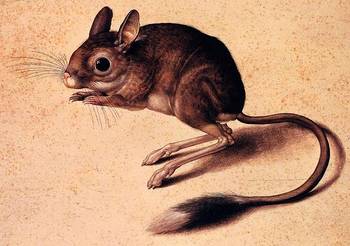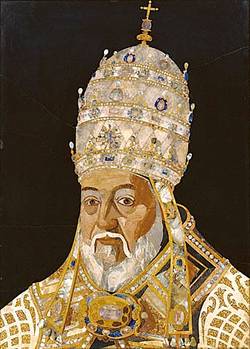An exhibition devoted to Jacopo Ligozzi (c. 1549–1627) is open until 28th September in Palazzo Pitti in Florence.

But who was Ligozzi? Born around 1549 in Verona, he spent most of his life in Florence and is especially known for his scientific drawings from nature. But as the exhibition also illustrates, he had great success at the Medici court as he could turn his hand to designing all kinds of things for them: from decorative harnesses for their horses to pietre dure table tops and embroidered head-dresses for the duchesses. But in order not to depend on the favours of the ruling family at any one time, and to ensure he could always earn his bread and butter, he also produced numerous paintings. This exhibition illustrates the diversity of his talents as well as his eccentricities.
It opens in the magnificent Sala Bianca, the Pitti’s 18th-century ballroom, with a small selection of watercolours of fish, plants, birds, mice and moles, commissioned over a period of some ten years at the end of the 16th century by Francesco I, who was famous for his interest in the natural sciences. The second half of the room has drawings made by Ligozzi for the apparatus used on ceremonial occasions, and two paintings by him of ladies of the court proudly wearing the paraphernalia designed him (that of Margherita Gonzaga is on loan from Lisbon). The designs for bizarre goblets, including an entire album of them, become so intricate that some of them begin to resemble the crazy inventions of Heath Robinson. In contrast, the exquisite pen-and-ink wash drawing of Portoferraio shows what a great talent Ligozzi had for landscape.

There are some magnificent examples of pietre dure work on show. Tabletops closely covered with inlays of precious stones portraying all manner of flowers and birds are displayed without their pedestals and can be seen to full advantage.
A small room contains some very macabre works, two of them on the verso of painted portraits of a lady and of a boy, both from the private collection of Lord Aberconway in Bodnant, Wales. These memento mori fully deserve the description of them given in situ as ‘repugnant’ and ‘savage’. Also here are four drawings of the Cardinal Sins, reunited from Paris (the Louvre) and Hanover. A small allegory of the Redemption from a private collection in Madrid is similarly disturbing. The dark atmosphere is only alleviated by the music provided in this room (and close by, one can go out into the little loggetta, which has a charming ceiling frescoed in 1588 by Alessandro Allori of wash day in the palace).
The last four rooms display Ligozzi’s oil paintings, which vary greatly in interest and quality. Those painted in the 1590s for the little-visited Florentine church of San Giovannino degli Scolopi (in Via Martelli, two steps from the Baptistery) are among the best: Jacob’s Dream and The Fall of Lucifer, which form a pair, and St Jerome Comforted by an Angel, with exquisite details of his piles of books and the angel in a beautiful dress. Ligozzi is known to have been a deeply religious man and his son became a Dominican friar, but his best paintings are those with an element of eccentricity, either in the composition or the details. His Madonna of the Rosary has a rather mundane Mother but a delightful Child, and they are set in a garland of roses of varieties which go from cream to deep red. Next to it hangs a Transport of St Catherine which shows the Saint stretched out comfortably (the pose has faint echoes of Mary Poppins) as she floats aloft with the help of angels. There are also some much larger altarpieces, one of the best of which is Mary Magdalen in Adoration of the Crucifix set in a wood, which is over 3 by 2 metres, painted in 1607 for the church of San Martino in Pisa. Also displayed here is a guide book to the convent of La Verna, written and illustrated by Ligozzi and complete with keyed plans: it seems that he wanted to turn his hand to everything!
The small last room has arguably his best oil paintings: four Passion scenes. They show Ligozzi’s imaginative creativity in their composition and use of colour, as well as fascinating details in the hats, armour, bejewelled costumes, and landscapes.
This is the first time that due attention has been paid to all aspects of Ligozzi’s work. It is an exhibition well worth seeing.
by Alta Macadam, author of Blue Guide Florence.






